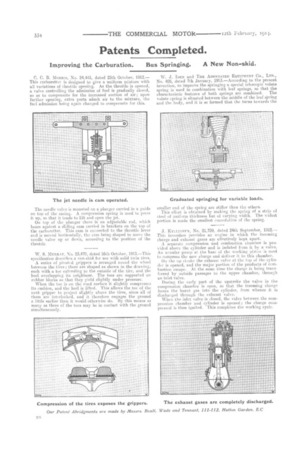Patents Completed.
Page 20

If you've noticed an error in this article please click here to report it so we can fix it.
Improving the Carburation. Bus Springing. A New Non-skid.
C. C. B. MORRIS, No. 24,445, dated 25th October, 1912.— This carburetter is designed to give a uniform mixture with all variations of throttle opening. As the throttle is opened, a valve controlling the admission of fuel is gradually closed, so as to compensate for the increased suction of air ; upon further opening, extra ports admit air to the mixture, the fuel admission being again changed to compensate for this.
The needle valve is mounted on a plunger carried in a guide on top of the casing. A compression spring is used to press it up, so that it tends to lift and open the jet.
On top of the plunger there is an adjustable rod, which bears against a sliding cam carried in brackets on the top of the carburetter. This cam is connected to the throttle lever and is moved horizontally, the cam being shaped to move the needle valve up or down, according to the position of the throttle W. S. MurtnaY, No. 23,470, dated 16th October, 1913.—This specification describes a non-skid for use with solid twin tires.
A series of pivoted grippers is arranged round the wheel between the ti-es; these are shaped as shown in the drawing, each with a toe extending to the outside of the tire, and the heel overlapping its neig,hbour. The toes are supported on rubber blocks so that they yield slightly under pressure. When the toe is on the road surface it slightly compresses its cushion, and the heel is lifted. This allows the toe of the next gripper to project slightly above the tires, since all of them are interlocked, and it therefore engages the ground a little earlier than it would otherwise do. By this means as many as three of the toes may be in contact with the ground simultaneously. W. J. IDEN and THE ASSOCIATED EQUIPMENT CO., LTD., No. 495, dated 7th January, 1913.—According to the present invention, to improve the springing a special telescopic volute spring is used in combination with leaf springs, so that the characteristic features of both springs are combined. The volute spring is situated between the middle of the leaf pring and the body, and it is so formed that the turns towards the smaller end of the spring are stiffer than the others. This effect is obtained by making the spring of a strip of steel of uniform thickness but of varying width. The widest portion is made the smallest convolution of the spring.
J. li.-nuatcrte, No. 21,759, dated 24th September, 1912.— This invention nrovides an engine in which the incoming charge and exhaust gases are effectively kept apart.
A separate compression and combustion chomber is provided above the cylinder and is isolated from it by a valve. An annular pump at the base of the working piston is used to compress the new charge and deliver it to this chamber.
On the up Etroke the exhaust valve at the top of the cylinder is opened, and the major portion of the products of combustion escape. At the same time the charge is being transferred by outside passages to the upper chamber, through an inlet valve.
During the early part of the upstroke the valve in the compression chamber is open, so that the incoming charge forces the burnt gas into the cylinder, from whence it is discharged through the exhaust valve. When the inlet valve is closed, the valve between the compression chamber and cylinder is opened ; the charge compressed is then ignited. This completes the working cycle.




















